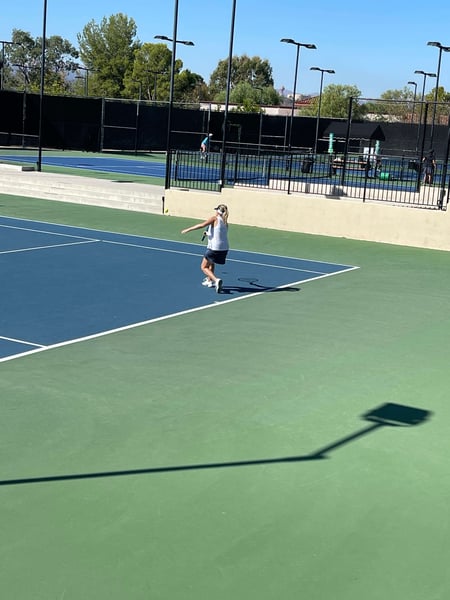Best 9 exercises for seniors to maintain strength, coordination, and mobility
September 19th, 2022 | 4 min. read
By Jen Azevedo
As you age, your body naturally becomes frailer. Bone density decreases, muscles lose capacity, and the heart works harder to circulate blood throughout the body.
Maintaining strength, balance, and mobility becomes more difficult each passing year.
The Center for Disease Control recommends a minimum of two and a half hours of movement per week for seniors.
Activities should include a combination of aerobic, strength, and mobilizing exercises. By following these guidelines, seniors can stay healthy and active well into their golden years.
Paseo Club has supported seniors in their fitness goals for almost twenty years. We have many facilities for seniors — tennis and pickleball courts, a junior-Olympic swimming pool, and fitness classes of all types.
In this article, we will share with you the nine best movements seniors can do to be physically fit so they can have good vitality and enjoy all of their favorite pastimes.
Best exercises for seniors
1. Planks
This basic static movement is a great exercise for core training. Planks can scale in many ways for athletes of all abilities.
Once you get into the best plank version for you, experiment with 30-second to 2-minute holds, alternating with an equal amount of rest. Or you can try a Tabata of 20 seconds of work and 10 seconds of rest for four minutes.
The benefits of planks are:
- Improves posture
- Builds core stability
- Strengthens glutes
- Enhance overall muscle endurance
- Strengthens and stabilizes shoulders
2. Chin-ups
Strength or resistance training is one of the most important (and often underutilized) forms of exercise that seniors should do.
Strength training helps slow muscle loss and aids in coordination and balance.
Chin-ups and pull-ups are a form of resistance training that is great for strengthening arms, back, chest, and shoulders.
For people who can almost do chin-ups and want to build their skills, they can try doing negative pull-ups, jumping pull-ups, or assisted pull-ups on the bar at the gym.
Many people, especially women, cannot do chin-ups at all. Ring rows are a great alternative that exercises almost all of the same muscles but is easier to do.
Another approach to work the same muscles is to row on the machine (pulling) and alternate it with push-ups (pushing).
3. Swimming
One of the most noticeable changes elders experience is joint pain — especially when involved in high-impact activities.
Running, high-impact aerobics, and sports such as basketball or soccer can become too painful to do.
Switching your workouts to low-impact activities is a great way to keep getting your cardio exercise in while staying safe and pain-free.
Swimming is the most highly recommended sport for all ages. It is gentle on the joints, great for stamina, and excellent for keeping a stronger core.
4. Stationary bike
Indoor bike riding is the second-best cardio exercise after swimming.
It is excellent for building endurance and strengthening your legs with only minimal strain on your knees.
Stationary bike workouts vary in duration and intensity, which makes them customizable for athletes of all abilities. Many indoor bikes pair with apps that provide pre-made workouts to follow.
Alternately, join a cycle class to enjoy the encouragement of an instructor and the camaraderie of your fellow cyclists.
5. Resistance band exercises
Resistance bands are large elastic bands created for mobility and resistance training. Some bands are made in a loop, while others are one long strip of elastic with handles on either end.
Resistance bands are color-coded to denote varying levels of resistance. Many bands are sold in a pack so you can select the band you need depending on the movement and your fitness level.
They also pack up small, making them great for home or travel workouts.
Several movements that can be done with resistance bands:
- Squats
- Bicep curl
- Glute bridge
- Chest presses
- Seated calf press
- Lateral arm raises
- Tricep to overhead press
6. Elliptical trainers
Ellipticals offer a low-impact cardio workout. Depending on the type of elliptical you select, you can run, walk, or climb your way to fitness.
It is a great option for people looking to transition away from running to something gentler on the joints.
Some ellipticals exercise only the lower body. But for a full-body workout, look for the ellipticals that also engage the arms.
These machines provide a supported platform that helps stabilize the user but simultaneously builds core strength for better balance in and out of the gym.
7. Tennis

Cardio exercise supports heart and lung health and reduces the risks of cardiovascular disease and diabetes.
Whether you like singles or doubles tennis, this is a sport for a great aerobic workout that also aids balance and coordination. Tennis engages the lower body, upper body, and core, making it a full-body workout.
Playing tennis has mental and emotional benefits as well.
It is associated with lowered stress levels and decreased depression. Since you are playing with another person, it becomes a social connection, which boosts the mood too.
8. Yoga
One of the toughest things about aging is getting stiffer, achier, and less flexible.
The amount of lubricating fluid inside joints decreases, and cartilage becomes thinner. Ligaments also tend to shorten and lose some flexibility.
Due to these changes, mobility becomes a more prominent feature in seniors’ exercise routines. It not only helps you feel better, but it also allows for more engagement in the physical activities you enjoy and lessens the risk of injury.
Yoga is a great mind-body practice that incorporates breath, movement, stretching, and balance.
It helps calm and soothe busy minds, and lengthens and relaxes muscles and tendons.
9. Pilates
Pilates is done on machines called reformers or on a yoga mat. It emphasizes core strength, coordination, mobility, and controlled movement.
Pilates is a method of exercise developed by the founder, Joseph Pilates, in England in the early 1900s. He developed this system of exercise and body conditioning first for rehabilitating soldiers and later for dancers.
Many people turn to Pilates when recovering from injuries or to improve flexibility. People of all ages love it and use it to cross-train for their favorite sports.
Final thoughts about exercises for seniors
It is normal to need to adjust your fitness goals as you age. You may need to reduce the weight you lift, shorten the laps you swim, or play a slightly less rigorous game of tennis.
But that does not mean you need to stop being active entirely. In fact, exercising in your fifties, sixties, and seventies is one of the most crucial steps taken to increase the quality of life and extend longevity.
The Paseo Club is always inspired by our senior athletes and fitness enthusiasts. We offer several exercise classes every day, including cycle, Pilates, yoga, strength training, and liquid cardio, for seniors and all club members.
Socializing is also one of the key components of staying healthy as you age. The Paseo Club is not a fitness club, it is a social club.
Members are invited to Wine Down Wednesday, Pilates and Pinot, Friday Night Fiesta, and many other social, athletic, and charity events.
Are you in the Santa Clarita Valley and looking for a place to visit with friends of all ages and get fit? Then the Paseo Club is the place for you. Join the Paseo Club today.
Jen Azevedo is a tennis professional, pickleball professional, personal trainer, group exercise instructor, and the general manager of the Paseo Club. She loves the community at the Paseo Club and that it is also a safe and fun place for her daughter. Jen’s favorite activities are joining her tribe for trail races or her partners for tennis matches. Occasionally Jen slows down to relax with a book — she reads over 100 a year!

